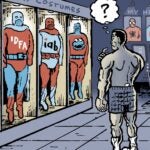 Monster.com’s new CMO, Jonathan Beamer, has a monster job ahead of him.
Monster.com’s new CMO, Jonathan Beamer, has a monster job ahead of him.
Since its heyday in the late ’90s and early 2000s, the career site, once the most trafficked job platform in the US, lost ground to upstart competitors such as Indeed.com and ZipRecruiter.
Monster rested on its laurels, and what started as a scrappy challenger brand in 1994 became large and lumbering.
“We let the competition pass us by,” said Beamer, who took the reins as chief marketing exec in November.
But Monster is ready to reclaim its spot with consumers who feel nostalgic for the brand. Beamer calls it “latent favorability.”
“When you remind people that Monster still exists – and you do have to remind people that we’re still around – they say, ‘Yes, I remember really liking them,’” Beamer said. “A lot of people are rooting for Monster, and shame on us for letting the house fall into disrepair over the last decade.”
Before hopping aboard at Monster, Beamer held senior marketing positions at Progressive Insurance and solar energy firm SolarCity. He also spent nearly nine years agency-side at Digitas.
AdExchanger spoke with Beamer about his plans to revivify the Monster brand.
 AdExchanger: Why did Monster’s house “fall into disrepair”?
AdExchanger: Why did Monster’s house “fall into disrepair”?
JONATHAN BEAMER: Indeed didn’t do anything brilliant, but they brilliantly executed the model that we created. In particular, they designed a product that worked perfectly for Google and sourced a lot of free traffic. That is where Monster just kind of watched them go by, even though it’s a category we created.
How do you plan to modernize Monster?
Our purpose is to make job seeking, which is admittedly an awful process – it still is and always will be – less so. We have to be honest that looking for a job is difficult, it’s emotional and the employer has more power and control than you do.
We’re building tools to be on the side of the job seeker, and that means something different than it did 20 years ago when we first started. But I still don’t think anyone is doing it really well. Job seekers still have to sift through a lot of job postings based on two-word searches rather than be expertly matched based on their passions.
What’s the marketing strategy? What are you changing? What are you keeping?
We need to modernize our marketing stack and tech stack so we’re able to get a message out at the right price point and target the people we want to talk to. We’ve been behind there.
The really fun part is actually the other piece we’re investing in, which is our product. We have to be in the places and on the devices job seekers are actually using today, and that hasn’t been the case. Our mobile app is pretty good now, but our mobile web presence still isn’t.
We have a pretty good job distribution function, which puts our jobs on other people’s sites, although it’s not where we want it to be. We also have a relatively good email program and a pretty good social jobs footprint, because that is a product we actually sell.
Monster’s ad stack has relied on outside media agencies, and we still do.
What about bringing some of that in-house?
At Progressive Insurance, we ran a full in-house media-buying team, and we primarily did that so we would have data. At SolarCity, we built an in-house media team with a DMP so we could do tracking. We had a highly targeted product and we also needed to track along what was a long sales funnel.
At Monster, we were kind of half in and half out with our external partners, but if you’re not tying data together really closely, you can’t have a programmatic media program that performs. Just now in North America we’re trying to pull our buying in-house and build a DMP so we can ensure that we’re balancing our marketplace.
How do you decide what to partner on and what to build?
There’s so much good ad tech out there, so when it comes to making a build-vs.-buy decision, I encourage the team to think about whether what we need is unique to Monster. If not, we can probably buy it or rent it, especially since we’re a company that’s a little behind.
But we want to build things that can differentiate us. For example, when we drive people to look at a job posting, we want the experience to be satisfying and well-trafficked. The marketplace balance piece is something we need to build and we have a team to understand the analytics behind it. But we’re not going to download an open-source ad server and start customizing it for Monster.
What do you think of the in-housing trend in general?
On the one hand, there isn’t enough talent in the world for everyone to have an awesome in-house team. But I look for active learners. I’m certainly not using the same skills I learned in school 20 years ago. We need folks that are willing to experiment.
And, managed well, external agencies can do a really nice job, but you also have to be fluid with that boundary and share a lot of data. When I moved from the agency side to the client side, I pledged that I would always be the type of client I used to love working for. When I loved my client, I worked really hard for them – probably more hours than were actually billed.
But I’ve seen engagements where we don’t even know who we’re supposed to be talking to at the agency. There’s no way you’re getting value from that relationship.












